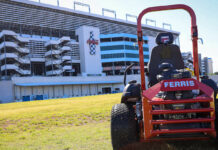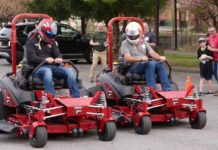B&S Senior Engineer Steve Lavender on the development of a new commercial power plant
Q: Briefly share your history with Briggs & Stratton and your role in the development of the new Vanguard 810cc commercial engine.
A: I have been with Briggs & Stratton for 28 years. I started here as an entry-level project engineer in what was then called the Large Engine Group. At that time, large engines meant 5 to 18 hp. My career progressed through senior project engineer, leading the design team that introduced the Intek V-Twin in 1995. I held engineering manager positions for Large Engines and New Product Development. I now have responsibility for all engine design and development as senior director of engineering for the Engines Group.
In my role I oversee a talented and experienced group of managers, engineers, designers and technicians responsible for executing our product plan. It is my responsibility to assemble the best engineering team and ensure that team has the direction, tools and resources to accomplish our goals for each project.
For the 810 project, we needed engineers with experience on other Vanguard programs who understood the challenges associated with the durability and reliability goals. We surrounded them with experienced designers and technicians.
Q: Tell us why you and others on the Briggs & Stratton team felt there was a need for a new commercial engine of that particular size and horsepower (24 and 26 gross hp models).
A: We had a gap in our Vanguard engine lineup between our Small Block Twins, which range up to 627cc, and our Big Block Twins, which start at 896cc. The most popular horsepower range for commercial turf applications falls right into the range covering the high end of the Small Blocks and low end of the Big Blocks. Detuning a Big Block is not a cost-effective solution. When it comes to meeting the torque requirements we needed more displacement than we could achieve on the Small Block platform, especially considering the durability requirements. What we needed was a Mid Block. Recognizing a trend toward increasing displacement in this category we chose to go above the midpoint of the gap so that’s where the 810 comes in.
Q: What was the timeline associated with the product, from initial discussions to its commercial production?
A: Total calendar time from project approval to start of production (SOP) is about two years. Discussions regarding the need for a Mid Block took place for as much as a year prior to that to put the business case together.
The timing of events for a project like the 810 is critical, as we have to meet customer delivery needs for their own test schedules as well as their SOP. Of course, in this industry, these dates are dictated by grass cutting seasons. Timing our multiple phases of testing, customer testing and SOP dates within a two-year window required a great deal of coordination.
Q: Please share why this engine is being assembled in your company’s Auburn, Ala., plant.
A: Our Auburn plant is where our consumer V-Twin product line has been manufactured since its introduction in 1995. Other engines manufactured at that plant during that time have since been relocated. So we looked at the synergies of making the new engine there while installing a unique Vanguard manufacturing facility within the plant. Using one of our existing domestic ride engine plants has the added advantage of proximity to our customers.
Q: What makes this particular commercial engine special in your opinion?
A: We designed the 810 from the outset to be the best possible power solution for this segment of commercial turf equipment. The 810 team has done an outstanding job of addressing the special requirements these machines demand. The air management system designed to keep the engine clean and cool in dirty operating conditions is certainly one of the most visible differentiating features.
Q:What challenges did you and the development team overcome to make this a unique product?
A: Design goals for the 810 were developed by translating customer needs into design requirements and specifications. This involved marketing, product management and engineering spending time with OEM customers and commercial cutters to make sure we fully understood both the challenges and opportunities.
The opportunities drove the unique features. The challenges were all in the execution and timing.
New ANSI standards requiring stationary guarding over the fan inlet has typically been addressed by placing an additional screen over the fan inlet. We were able to incorporate the requirement with a complete rethink of how to maximize clean airflow through the cooling system and the intake air filter.
With a 2,000-hour expected life requirement, there was little room in the schedule for do-overs. Finding failures close to the end of a 2,000-hour endurance test means redesigns and another 2,000 hours retesting. With such long test hours it wouldn’t take much to miss a whole season.
We implemented Lean Design and Design for Six Sigma (DFSS) tools to improve our ability to uncover potential issues and validate solutions more efficiently and effectively.
By the time the production tooled product validation (PV) test engines were built, each new component and subsystem had already demonstrated its ability to meet requirements. PV testing was as uneventful as we needed it to be.
I am very pleased with the results of this team’s work.
PHOTOS: BRIGGS & STRATTON











![[VIDEO] Dickies®: Discover Workwear That’s Anything But Uniform](https://turfmagazine.com/wp-content/uploads/2023/06/1647663814-4b1a2a7742790a9b1e97a3b963477850192e1d6a9dfba9b07214a77bae25d6e3-d-218x150.jpg)
































![[VIDEO] Dickies®: Discover Workwear That’s Anything But Uniform](https://turfmagazine.com/wp-content/uploads/2023/06/1647663814-4b1a2a7742790a9b1e97a3b963477850192e1d6a9dfba9b07214a77bae25d6e3-d-324x160.jpg)